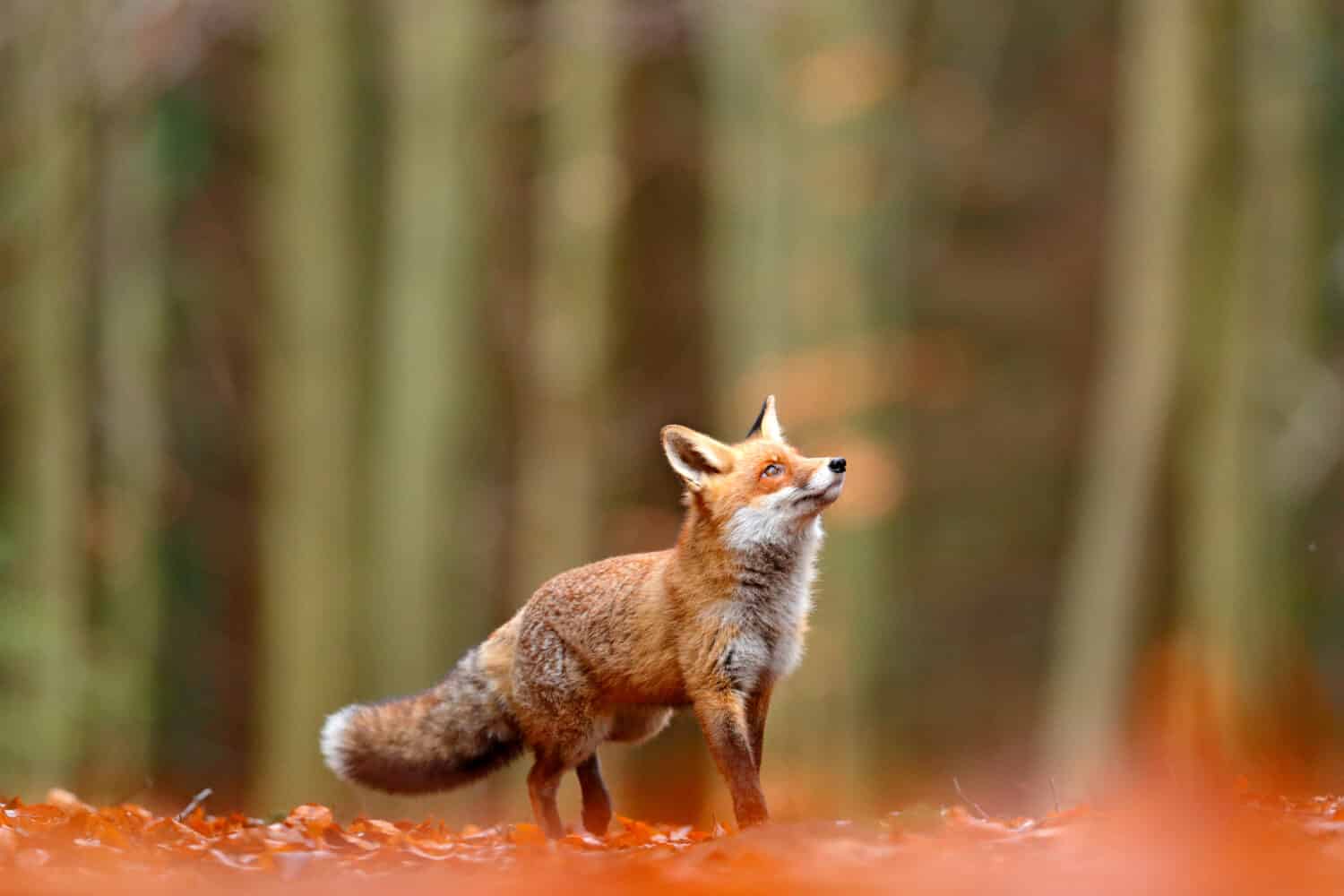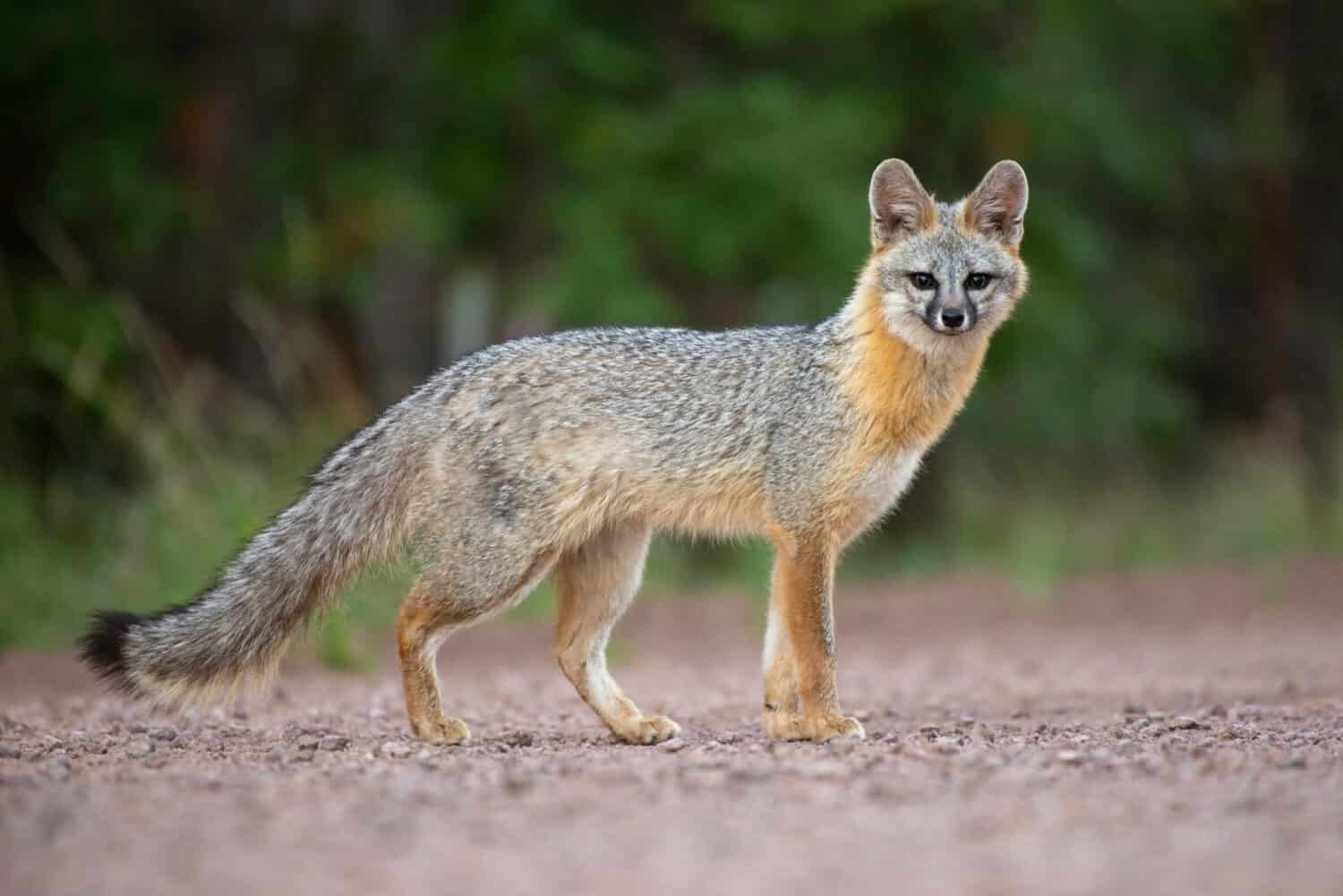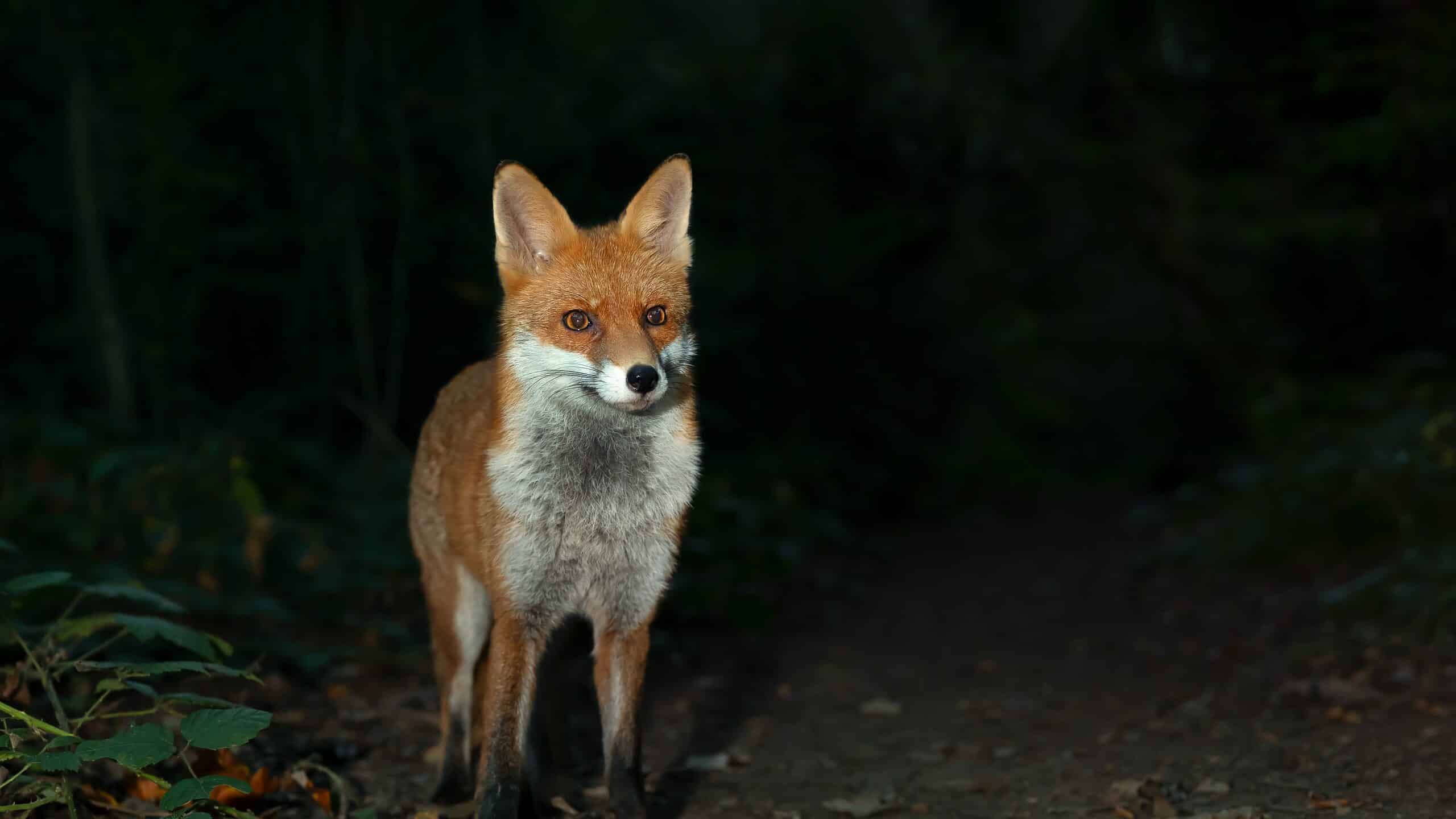Red and gray foxes in Connecticut are easy to spot. The most common habitats include forested areas, and, in some places, they habitats are close to human settlements.
Both the red fox and the gray fox are omnivores. They eat vegetation and fruits, including what they find in the garbage. Both foxes also hunt birds, amphibians, rodents, and other small animals.
Red Fox
Connecticut is home to the red fox, one of the most tenacious carnivores in North America. It’s also found in many other parts of the world. The red fox can survive in different climates ranging from the coldest to the hottest.

Red foxes are wise hunters and can be pretty cunning.
©Ondrej Prosicky/Shutterstock.com
In Connecticut, these foxes live near human populations. However, they can be elusive and not easy to encounter. They are wise and cunning hunters, which explains why they are featured in the stories of ancient cultures.
The red foxes in North America live as part of a small group or as mating pairs. They are quite widespread and have over 35 subspecies.
Evolution
The red fox has been around for a long time. The earliest fossil evidence of the red fox is from the Pleistocene period. That’s between 11,570 to 2,580,000. Evidence indicates the red fox originated in Eurasian after fossils were discovered in Hungary.
Early red foxes were likely smaller than the current species. Most likely, these foxes lived next to the earliest human settlements. Humans would hunt them for their pelts and as a source of food.
Later, the red fox colonized North America in two waves. The first was during the Illinoian glaciation period. The second was during the Wisconsin glaciation period. Fossils have been discovered in different parts of the U.S.
Description
The red fox is quite distinctive in appearance. An adult has short limbs and an elongated body. The tail is longer than half its body size and can reach the ground when the fox stands. It’s also a bushy tail that makes it easy to identify the red fox.
Red foxes also have a snout, pointed ears, and vertically oriented oval pupils. The hind legs have four digits, while the forepaws have five. Short legs make it easy for red foxes to jump and be agile.
Each red fox has fur made up of two layers. First, the outer layer is coarse and acts as protection. Then, the red fox has a soft inner layer.
Most red fox subspecies have a red-orange outer coat on the upper parts. The area beneath the face, including the tail and chest areas, is white. Parts of the tail and legs have black fur.
In addition, the red fox has long canine teeth and a small braincase. The male red foxes have bigger skulls than the females. Adult red foxes can measure between 26-42 inches long and weigh 10 to 15 pounds.
Behavior
Red foxes do belong to the same taxonomical family as wolves. However, it’s important to note that the two animals differ in behavior. Red foxes don’t form packs like wolves and can be pretty territorial.
An adult male can have one or two females in its territory simultaneously. It also allows their offspring in the territory, but not other red foxes. A male red fox maintains a territory that varies in size ranging from five to 20 square miles.
They prefer to live in dens or burrows that offer maximum protection, especially for the offspring. The main den is in the territory, and several emergency caves are in the area. Red foxes prefer to dig their burrows in rock clefts, ravines, and banks.
Many prefer to take over existing burrows of other smaller creatures, such as rabbits. However, the red fox can still dig a new burrow to create a den. Many prefer raising numerous offspring in one den, which can go on for generations.
The red fox is one of the most intelligent creatures. They do have a distinct way of communicating that includes body language. The red fox also marks their territory using scents on rocks and trees using feces, urine, and liquid from body glands.
The red fox is most active at night. It prefers to hunt just before dawn or as dusk approaches. They have a wide range of vocals that they use for communication. Kits tend to make an average of eight sounds, while adults have 12.
Distribution
The red fox is widely spread in North America, including Connecticut. Places with open fields and forests are the favorites for this nocturnal animal. Red foxes prefer to hunt on the edges of the two spots.
It’s also not uncommon to find a red fox hunting for small prey in urban areas. And this has led to lots of conflict with people who consider the red fox a pest.
Every species prefers a specific habitat. Some can also exist in a mixture of habitats with good hunting grounds. As an omnivore, it heads out foraging for different food sources and can even come into chicken coups.
Reproduction
Red foxes give birth to young during spring when the weather is much more favorable. Reproduction happens once a year, and a female will give birth to four to six kits. However, there are records of females giving birth to over ten kits per cycle.
The young red fox is born toothless, deaf, and blind. They also have fluffy and dark fur and a large head. Kits can spend 14 to 21 days with their mother to enable thermoregulation. Mom never ventures out, and it’s the role of the male to feed her.
After 15 days, the kits open their eyes and ear canal. They also develop their upper teeth, followed by the lower ones about four days later. The coat will change from dark to a lighter shade in three weeks.
The kits are strong enough to emerge from the den at four weeks old. They can also nibble on solid food and grow into adulthood at six to seven months.
Red foxes in Connecticut can live for 10 to 12 years, depending on the environment. They live long in captivity, where conditions are much more favorable. However, they only live in the wild for two to four years.
Older kits stick around to help their parents in raising the young. It explains why you can come across a large family of red foxes. The family unit is strong and plays an important role in their survival.
Diet
Red foxes in Connecticut and other parts of North America aren’t picky about what they eat. As mentioned earlier, these are omnivorous animals. They eat a wide range of food depending on the location.
The red fox forages for plants and fruits in the wild. They also rummage through garbage to find leftovers. Additionally, red foxes hunt small rodents, amphibians, fish, eggs, birds, and rabbits.
Gray Fox
Connecticut is also home to the gray fox, another omnivorous mammal in North America. It’s a cousin of the red fox and shares some of their behaviors.

Evidence shows that the gray fox existed in North America almost 3.6 million years ago.
©Sean R. Stubben/Shutterstock.com
Gray foxes are largely distributed across North America and prefer living in hollow tree trunks. They are one of the canines that can climb trees. They also run fast and can reach top speeds of 28 miles per hour.
Evolution
Evidence shows that the gray fox existed in North America almost 3.6 million years ago. It was during the mid-Pliocene epoch. The first fossil of the gray fox was discovered in Arizona at the Lower 111 Ranch site in Graham County.
There are six subspecies of the gray fox in North America. They share the closest resemblance with the island fox.
Description
One way to distinguish the gray foxes in Connecticut is with the black stripe down their tails. They also have strong necks, pointed ears, and muzzles.
Male gray foxes are slightly bigger than the females. They can vary in size ranging between 29 and 44 inches long. An adult can weigh between eight to 15 lbs.
A difference between the red fox and the gray sox is the lack of black fur on the feet. The gray fox has white ears, a throat, hind legs, and a belly. It also has a black stripe that runs in the middle of the tail. They also have black on the nose, lips, and eyes.
Behavior
The gray fox has the unique ability to climb trees for different reasons. First, this can reach a food source in the trees, like a nest with eggs. Second, the gray fox climbs trees to avoid predators like wolves or coyotes.
The gray fox has hooked claws strong enough to support the animals while ascending trees. The best are vertical tree trunks that don’t have many branches. A gray fox can scale up to 18 meters from the ground and reach food sources on the branches.
In the past, the gray fox lived primarily in deciduous forests. However, human settlement forces the gray fox to adapt. It’s not uncommon to find gray foxes living near human settlements or hardwood forests. Forested areas are better when the gray fox needs to escape coyotes.
They are nocturnal creatures, and they make their dens on tree hollows. Tree dens can be up to 30 feet off the ground, keeping them safe. The gray fox can rest on the ground and up the tree to escape danger.
A gray fox starts off living a solitary life. Then they find a partner to form a family unit. They mark their territory and have the largest scent gland of any canine in North America. They also have a remarkable scent that makes it easy to note different territories.
Gray foxes use both body language and sound to communicate. Certain body stances communicate different messages. In addition, they make a wide range of noises, such as screaming, yapping, and growling, to communicate.
Distribution
The gray fox inhabits different parts of North America, including Connecticut. They prefer areas with lots of brush, rocks, and forests. Sites with more covering can see huge numbers of gray foxes.
Reproduction
The gray fox will start breeding in January through March. Females have a gestation period of 53 days, after which they give birth to kits. Each female can give birth to an average of four to six kits annually.
Since the gray fox can climb trees to escape danger or reach for food, they also prefer such places for dens. They can pick tree trunks, high rock crevices, and dense brush to set up a den.
In addition, the gray fox will have multiple dens in their territory. In case of danger in one area, they can easily relocate the pups to a different and safe area. Both male and female foxes take turns caring for the young and hunting for food.
After four to five weeks, the kits can emerge from the den and begin exploring their surroundings. The pups are weaned at three months old and join their parents in hunting.
Diet
The gray fox is an omnivore that eats both plants and animals. They forage for plants and food in the wild. Gray foxes can also go through garbage to find food near human settlements. They also hunt small animals like amphibians, birds, and rodents.
Are Foxes a Problem in Connecticut?
The red and gray foxes are viewed as a threat to human populations in Connecticut. While they do remain elusive, there is potential for human-wildlife conflict. In most instances, foxes attack small domestic animals like chickens, ducks, rabbits, young goats, and sheep.
Gray and red foxes will prey on smaller livestock when people are asleep at night. They find ways to access the enclosures, including digging or squeezing in. In areas where foxes are a problem, finding ways to protect your livestock is essential.
Another importance of keeping foxes away is to prevent the spread of diseases. Both the red fox and gray fox carry organisms that spread contagious diseases. Sick animals can spread illnesses such as rabies and mange.
What to Do When You See Foxes in Connecticut?
Residents of Connecticut are advised against feeding foxes. They can pose great risks to humans, livestock, and pets. Feeding pets indoors is important to prevent foxes from accessing food in your yard or porches.
In addition, always check crawl spaces and clear areas with bushes around your home. Doing so prevents foxes from making dens too close to human settlements. Use all scare tactics like spraying water and bright lights to scare foxes away.
Thank you for reading! Have some feedback for us? Contact the AZ Animals editorial team.








